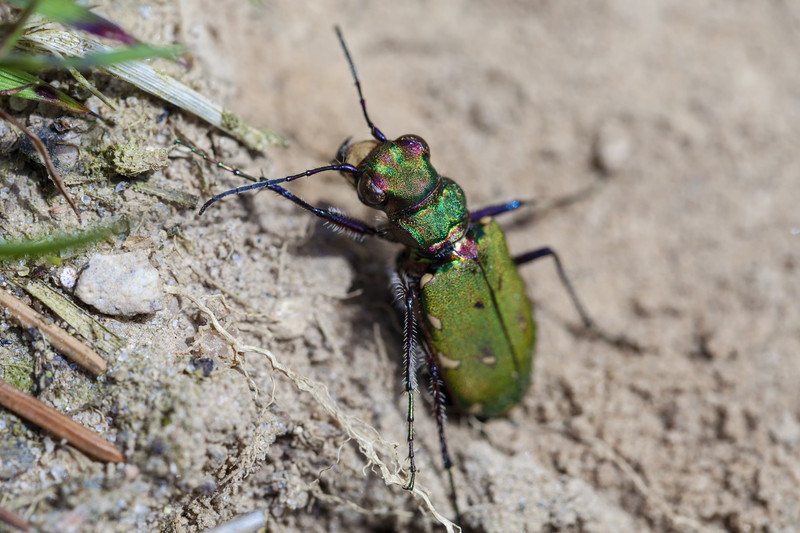The tiger beetle is usually a beneficial insect. It eats pest insects including ants, caterpillars, flies, grasshopper nymphs, and spiders. But sometimes tiger beetles eat their own and some other beneficial insects.
Tiger beetles are closely related to ground beetles, also beneficial insects, but unlike the ground beetle, the head of a tiger beetle is wider than its thorax—the section between the head and the abdomen.

There are more than 100 species of tiger beetles in North America and more than 2,000 species worldwide.
The tiger beetle belongs to the scientific family Carabidae.
How to identify tiger beetles
Tiger beetle adults are about ½ to ¾ inches long. They have long, spindly legs, large bulging eyes, pointed mandibles, and long antennae. Larvae are segmented with a pronounced hump with strong hooks on the fifth segment.
Tiger beetle feeding habits
Unlike ground beetles, most tiger beetles are active during the daytime. They are fast runners—as fast as five miles per hour–and can fly if need be. At night they are attracted to lights.
The adult tiger beetle has an acute vision. It will crouch and wait for its prey to pass then lunge and grab its target like a tiger. It clenches its prey between powerful sickle-like mandibles and devours it whole on the spot.
Tiger beetle larvae prey on soil-dwelling insects. They ambush their prey as they pass by the burrows in which they are born and mature.
Tiger beetle life cycle
A female tiger beetle lays 3 to 4 eggs per day. She deposits a single egg in a hole in damp sand or soil, covers it, and moves on. Eggs hatch in a few weeks and the larva takes two to four years to reach adulthood passing through three developmental stages.
Larvae tiger beetles dig burrows in the soil. They live in the burrows as they mature enlarging the burrows as necessary. They rarely leave their burrow but wait at the burrow’s entrance to ambush prey.
How to attract tiger beetles to the garden
Ground beetles are not attracted to the garden by specific plants, but a diversity of perennial plants will give them places to hide and find food. Tiger beetles take shelter under boards, rocks, tree bark, and garden debris during the day. You can encourage tiger beetles by providing shelter.
Related articles:
Vegetable Garden Organic Pest Control
Vegetable Garden Beneficial Insects
Vegetable Garden Diseases Problem Solver
Vegetable Garden Organic Weed Control
Garden Planning Books at Amazon:
- Vegetable Garden Almanac & Planner
- Kitchen Garden Grower’s Guide Vegetable Encyclopedia
- Vegetable Garden Grower’s Guide
- Tomato Grower’s Answer Book















